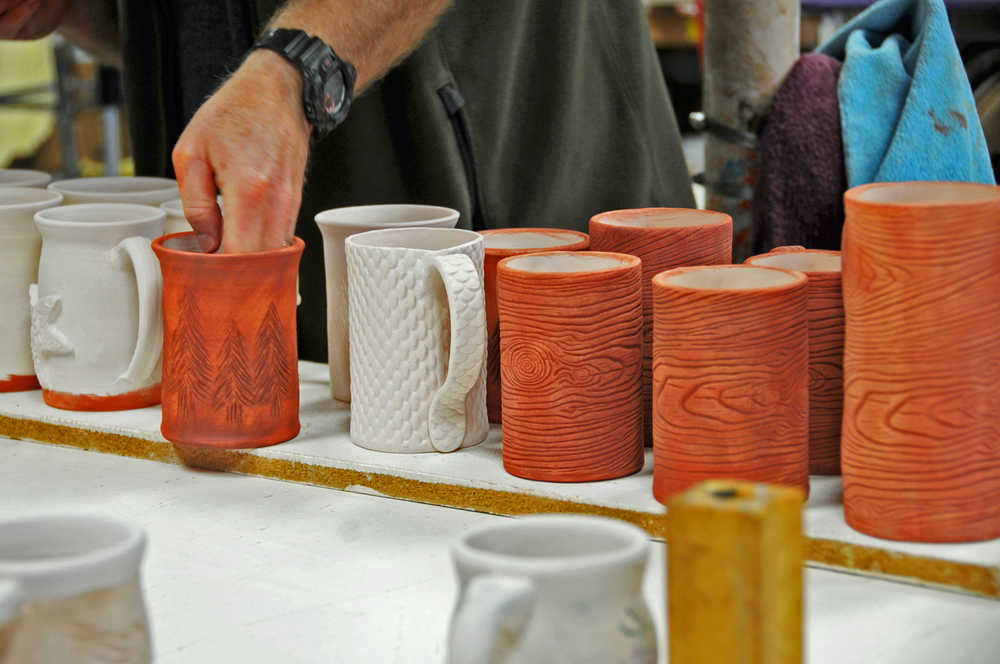A teacup may be impressed with the memory of a fingertip; a bowl can bear witness to the size of its maker’s hands. Amid the pottery carefully placed on shelves stacked to the ceiling, Laura Faeo can see people.
She pointed carefully to a set of delicate cups ringing, but not quite touching, a teapot of lily-pad green.
“I can look at a piece of pottery and say, ‘Oh, that’s hers,’” Faeo, a Nikiski resident, said. “I’ve just been doing this so long.”
Stepping back, Faeo rounded the corner of the enormous island in the center of the studio, a formica-topped surface lined neatly with unfinished mugs. The space is cluttered with shelves that stretch toward the 10-foot ceiling, pottery wheels and a slab roller. However, the plain concrete floor is immaculate, not a speck of dust to be found. Over the sink, Bryan Olds of Kenai was busily brushing his dry mugs with iron oxide.
“It comes out to a really nice leathery color, not really a glaze,” Faeo explained, indicating a neat line of clay bears on the other side of the table. “I do the same thing on the bears I make. It comes out this really nice brown, like leather.”
Faeo, the president of the Kenai Potters Guild, presided over the studio in Old Town Kenai, directing Mary Lou Wilcox as she loaded the gas-fired kiln. Wilcox, a relative newcomer to the potters’ guild, said she was happy to help, though she wasn’t loading any of her own pottery — it was all Faeo’s.
Faeo broke her wrist on the ice a few months ago and is still held up from making pottery or teaching classes, she said. In the meantime, she is teaching Wilcox how to do a firing do a firing. Learning to work the massive kiln is important if potters want the 12 hours of firing and two days of cooling to not go to waste.
“I’m the new one here,” Wilcox said. “I took one of Laura’s classes, and I was hooked.”
Things have changed, though. Faeo remembers the days when she slept on the couch in the Kenai Fine Arts Center, checking the fire on the kiln overnight to make sure it didn’t go out and the pottery came out right.
“You had to mind the fire, keep the kiln hot, so someone had to be here,” she said. “Not everybody was doing the firing. But I was. This was a big update when we got this kiln.”
The pottery studio attached to the Fine Arts Center in Kenai has been home to the guild for more than 40 years. After a scuffle over insurance in 2014, the guild is back home in its studio and preparing for its annual Mother’s Day sale, the proceeds of which go to help pay for utilities, rent and clay.
Though the guild hosts two well-known sales — the Mother’s Day sale and another at Christmas — it still mostly relies on membership fees for day-to-day operations. For $40 per month, members can rent shelves in the studio to store their pottery, and after becoming members, they can access the studio whenever they want.
Pottery can be an expensive hobby to jump into without a studio. While clay is fairly cheap and wheels are a relatively small investment, professional slab rollers can cost several hundred dollars, electric kilns can run into the thousands and brick kilns can go into the tens of thousands. That’s not even counting glaze, either purchasing it outright or learning how to make it from scratch.
The Kenai Potters Guild makes its own glaze, stored in dozens of white paint buckets beneath the main island in the studio. A cabinet full of ingredients like soda ash, silica and cobalt carbonate occupies a corner. Some of the glazes are traditional, like celadon — “a glaze that’s 3,000 years old,” Faeo said — and others are more experimental.
The experimental ones always run the risk of coming out wrong, though, Faeo said.
“You don’t want to glaze a bunch of different pieces and fire them with a particular glaze, because what if it comes out ugly?” Faeo said. “Then you’ve got a bunch of ugly pieces. It’s better to just do one and then test it.”
The uncertainty holds the thrill that keeps Olds coming back. A retired military veteran and current emergency room pool nurse, Olds said he and his wife both picked up pottery as a hobby. He lifts aside a tarp to show neat rows of mugs waiting to be fired, plain white sides decorated with a tacked-on octopus or sea star.
“The mugs are my wife’s, the sea stars are mine,” he said. “And I didn’t even throw those. I just shaped them in my hands and put them on.”
The presence of the pottery studio played a role in his and his wife’s move from Wasilla to Kenai, he said. A cooperative pottery studio where members can buy a membership and use the equipment is not common, Olds said. The one in Kenai is the only one he said he knows of in the state.
Selling pottery is not his main goal, though it is a side business, he said.
“It’s just really humbling, to have someone say, ‘Oh, that’s so cool,’ and want to buy something you made,” Olds said. “That’s a great part of it. That’s so humbling.”
From across the studio, Faeo chuckled.
“I love making the pottery,” she said. “Selling it I can tolerate.”
Reach Elizabeth Earl at elizabeth.earl@peninsulaclarion.com.

